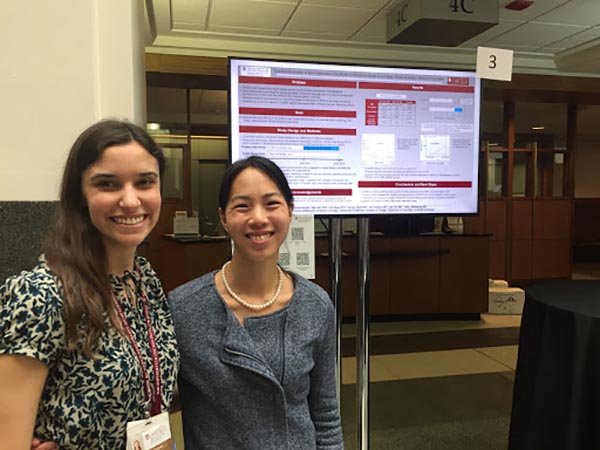PROMOTING SAFE AND EFFECTIVE PATIENT CARE
October 21-25, 2024
The University of Chicago Medicine’s annual Quality & Safety Symposium is an opportunity for faculty, staff, and trainees to showcase quality improvement projects that are in progress or have recently been completed from across the health system. This year in 2024, over 80 posters will be displayed in a virtual setting and the top posters will be shared at lunch each day of National Hospital Quality Week.
This year, on Friday, October 25th, HDSI will host an IN PERSON Symposium showing all posters, sharing health system quality and safety resources, and announcing the Building Trust & Choosing Wisely™ Challenge and Innovations Grant Program winners.
This event highlights UCM’s continued dedication to providing safe and effective patient care and the integration of these values throughout the medical center.
Get Inspired
Engage
Learn



National Healthcare Quality Week
Events
Daily Poster Review
Monday, October 21 – 12PM
Safety Poster Session
Moderator: Maria Macias
Director of Risk & Patient SafetyTuesday, October 22 – 12 PM
Timeliness Poster Session
Moderator: Diana Pop, MPH
Quality Program ManagerWednesday, October 23 – 12 PM
Effectiveness Poster Session
Moderator: Charlene Hope, PharmD, MS, CPHQ, CPPS
Chief Pharmacy Quality and Medication Safety OfficerThursday, October 24 – 12PM
Efficiency Poster Session
Moderator: James Williams
Vice President, Diversity, Equity and InclusionFriday, October 25 – 11AM
Patient Centeredness Poster Session
Moderator: Jenni Anderson MS, RN, NEA-BC, NPD-BC
Director Center for Nursing Excellence/Magnet Program Director
IN-PERSON Symposium
Events
Friday, October 25
12 PM Keynote- In-Person & Zoom
Denise Worrell, VP of Consumerism, Memorial Hermann Health System
12 PM in P117
2-4 PM Quality Resource Showcase
DCAM 4th Floor Atrium
- Human Centered Design
- Infection Control/SSI
- Risk Management and Patient Safety
- Quality Performance Improvement
- Patient Experience & Engagement Program
- Patient Care Services
- External Assessments
- ADAMS Center
- Transformative Care
2-4 PM Symposium Poster Session
DCAM 4th Floor Atrium
2-2:15 Innovations in Safety
2:15-2:30 Innovations in Timeliness
2:30-2:45 Innovations in Effectiveness
2:45-3 Innovations in Efficiency
3:45-4 Innovations in Patient-Centeredness3-3:45 PM Award Ceremony
DCAM 4th Floor Atrium
3pm Welcome
Tom Spiegal, Chief Quality Officer3:05pm President’s Address
Thomas “Tom” Jackiewicz, President of University of Chicago Health System3:15pm Poster Winners
TBD3:25pm Quality and Safety Award
Samantha Ruokis, Vice President of Clinical Performance Excellence3:30pm Building Trust & Choosing Wisely Challenge Winners
TBD3:35pm Innovation Grant Winners
Stephen Weber, Chief Medical Officer and Executive Vice President of Clinical Effectiveness
Awards
Poster Winners
- Top Poster in Equity: Partnering on Patient Safety: Improving Engagement with Event Report Reviews
- Top Adult Poster: Lab Stewardship BPA: An Informatics Approach to Reduce Inpatient Lab Orders
- Top Pediatric Poster: Vancomycin Area under the Curve and Trough Correlation in Pediatric Oncology Patients
- Top Poster Overall: Evaluating the Clinical Effect of a Discharge Pharmacy in the Adult Emergency Department on Return Emergency Visits and Readmissions
- Top Poster in Equity: Chronic Pain, Opioid Use and Opioid Use Disorder Management in Older Adults (I-COPE): Pragmatic Trial Development and Preliminary Results
- Top Adult Poster: Managing Hypertension through Remote Patient Monitoring
- Top Pediatric Poster: Simulation Training to Improve Pediatric Residents’ Recognition and Management of Acute Stroke
- Top Poster Overall: An Emergency Department “Surge” Program
- Top Poster in Equity: Establishing a Sickle Cell Disease Day Program to Address Acute Pain Crises & Continuity of Care
- Top Adult Poster: Proactive Advance Care Planning for Patients Undergoing Chemotherapy: A Focus on Healthcare Power of Attorney
- Top Pediatric Poster: Pediatric Early Response Team – From Debrief to Clinical Impact
- Top Poster Overall: Evaluation of a Transition Clinic to Bridge Emergency Department and Primary Care
- Top Poster in Equity: Identifying Racial Inequities in Hypertension Control
- Top Adult Poster: Automated Diagnosis (AutoDx): An Innovative Approach to Clinical Documentation Improvement
- Top Pediatric Poster: Streamlining Pediatric Antibiotic Approvals to Improve Efficiency and Fellow
- Top Poster Overall: CAUTI Reduction: An Interprofessional Project
- Impact on an Oncology Clinical Pharmacist Specialist in an Outpatient Multiple Myeloma Clinic
- Highly Reliable Fall Prevention: Engaging Frontline Staff
- Reduction in Age-Related Disparities in Depression Screening Before and After Implementation of a Medical Assistant Screening Protocol
- A Multi-Disciplinary Hip Fracture Program for UChicago Medicine
- Choosing Wisely Order S.M.A.R.T.T. Labs: Sleep: Making Appropriate Reductions in Testing & Timing
- UCARS Patient Transportation: University of Chicago Access Ride Service
- Improving Capacity and Patient Throughput
- The Gravity of Granularity: An ED Throughput Experiment
- Videotaping Traumas – Reducing Variation in IV Fluid Administration
- Medication Order-entry Modifications Significantly Reduce Anti-retroviral Medications Errors
- Epic Antimicrobial Stewardship Module Significantly Increases Safety Related Interventions
- Transport of Critically Ill Patients
- Reducing the Risk of Clostridium difficile Infection: Rethinking C.diff Testing at UCM
- Prevention of Elective Deliveries Less Than 39 Weeks and 0 Days Gestational Age
- Improving Patient Satisfaction Results- The Radiology Journey
- Scrub the Hub- Decreasing Central Line-Associated Bloodstream Infections (CLABSI) in the Pediatric Intensive Care Unit (PICU)
- Acute Cord Compression- Most Efficient Approach to Diagnosis
- Successful Central Line Associated Bloodstream Infection (CLABSI) Reduction Using a Multi-Disciplinary Approach
- Reduction of Voice Recognition Errors in Radiological Dictation- Effects of Systematic Individual Feedback
- Obstetrical Hemorrhage Management
- Antimicrobial Stewardship Initiatives to Optimize Vancomycin Dosing and Reduce Nephrotoxicity
- Applying ACLS and Pregnancy Modifications to Maternal Cardiac Arrest A Team-based Approach
- Ask Me to Explain Campaign: Improving Communication to Increase Patient Satisfaction in the Pediatric Emergency Department
- Colorectal Bundle: A Multi-disciplinary Teamwork Approach to Reduce Surgical Site Infections
- Identification of Clinical Factors for Performing Voriconazole (VRC) Therapeutic Drug Monitoring (TDM) at an Academic Medical Center
- Improving the Care Pathway for Total Joint Patients
- Pediatric Sepsis Initiative in the Emergency Room
- Protecting Patients from Self Harm: Implementation of An Evidence-Based Suicide Screening Process
- Teaching Patient-Centered Use of the Electronic Medical Record to Millennial Learners
Using Smart Forms to Discretely Capture Stroke Data for Electronic Reporting
